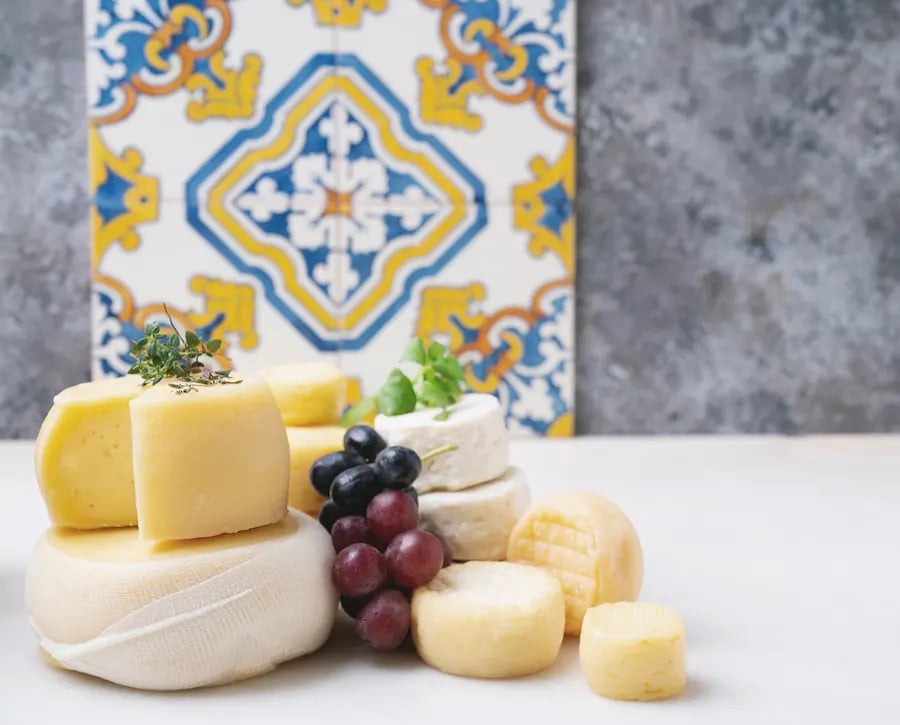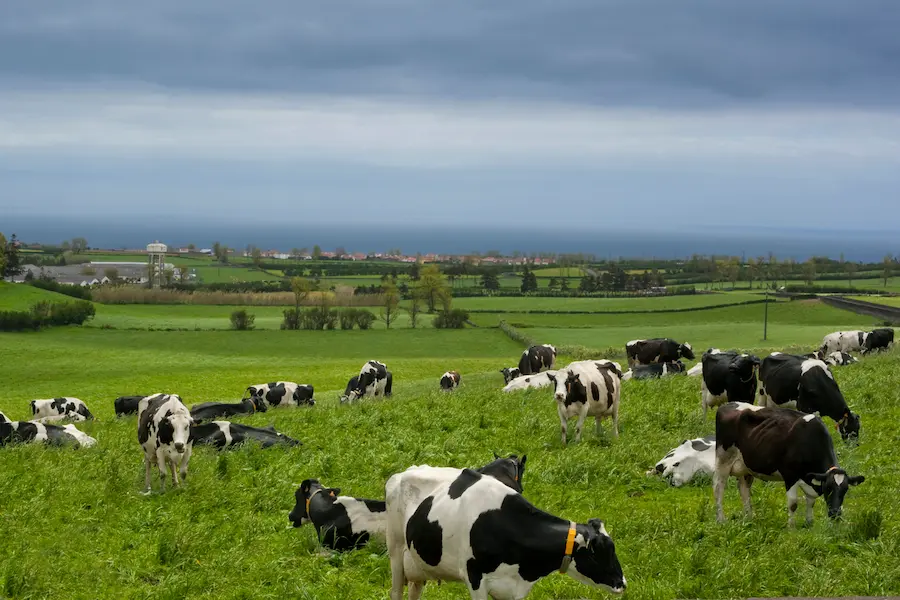The Azores is a Portuguese archipelago of nine volcanic islands in the middle of the Atlantic Ocean, accounting for 2.5% of Portugal´s surface area and 2,2% of the national population.
The dairy sector is a pillar of Azorean agriculture, with Milk Producers playing a crucial role in the region’s economy. This industry represents 70% of the archipelago’s agricultural activity. São Miguel and Terceira are the main dairy islands, with herds representing 30% of the dairy cows in Portugal. São Miguel represents only 32.1% of the total archipelago's area and contributes with around 65% of the Milk Producers output in the Azores1.
Pasture is the most representative of the land cover, surpassing other agricultural activities. Most dairy farms are small (20 a 50 ha) and have between 20 and 100 cows. This dairy basin has an average milk production of 6 216 kg/cow/year, with a predominance of pasture-based feeding and cows with a lower incidence of metabolic diseases such as acidosis, mastitis, and lameness2.
Milk producers in the Azores: a unique dairy industry
There are several factors that make the dairy industry unique in the Azores:
- Favorable natural conditions: mostly Temperate Oceanic climate, with temperatures around 15 to 25º throughout the year and an abundant amount of rain. The proximity of the ocean creates a natural sanitary barrier.

- Extensive grazing system: cows have access to natural pastures, outdoors, for most of the year. In this unique production system, the milking machine goes to the cow rather than the cow going to the milking machine. This extensive traditional system results in healthy animals, high quality milk and preservation of the environment.
- Sustainable production: Extensive grazing contributes to the preservation of biodiversity in the rangelands and many producers resort to environmentally friendly agricultural and waste management techniques. Priority is thus given to agricultural enhancement, returning to the soil the mineral components and organic matter necessary for plant development, minimizing the negative impacts of effluents on the environment.
- Variety of dairy products: the dairy industry in the Azores, in addition to fresh milk, includes a wide variety of products such as cheese, butter, yogurt and other derivatives. This allows producers to make the most of their milk production and meet different market demands.
Economic Sustainability
Azores is self-sufficient in milk and milk products except for yogurts and other similar products. Hence the target markets for the Azorean dairy sector are Portugal mainland and Madeira archipelago, while for the commodities like whey powder, skim milk powder and others, their market is global. Most Azorean dairy products are sold in the form of UHT milk, cheeses, and conventional butter, competing directly with dairy products from other dairy regions in Portugal, especially in the north of Portugal, and in the European Union.
Therefore, questions of economic sustainability arise. Despite the relatively low labor and production costs, the fact that the main markets are located on Portugal Mainland increases shipping fares and consequently milk prices. Like other dairy regions, milk prices are mainly influenced by global demand and events. But for the Azores archipelago, the geographical disadvantage helped farmers to keep a more economically efficient dairy activity.
In order to complement the pasture and forages produced at the farms, animals are offered compound feed mainly during milking time. Hence, cereals and other commodities are imported. Although the Azores is located around 1500 Km from Portugal mainland, it is in the middle of the main routes of vessels transporting feed commodities from North and South America, as well as West Africa into Europe, which allows the local dairy sector to easily access feed commodities.
Parallel to the increase of economic efficiency, which must be based on the maximization of the pasture and forage production, as well as, reproductive and production performance, it is increasingly important to differentiate and value Azorean dairy products.
Dairy products in the Azores: examples of added value
In recent years, the Azores have resorted to a regional dairy sector strategy to differentiate themselves. This strategy is based on several points. One of them is the high quality of Azorean milk and its derivatives, which is perceived by consumers on a larger scale in mainland Portugal. Another point is tourism, which is associated with the landscape of green fields and dairy cows, has a positive impact on visitors and in its perception of Azorean dairy products.

Within this valuation framework, some examples of value-added dairy products can be found:
- “Happy cows” program: created in January 2015, it consists of “pasture milk” produced by cows that meet approximately 229 requirements and is subject to an audit process for subsequent certification. This social responsibility program is based on five pillars: pasture, animal welfare, food quality and safety, sustainable production, and efficiency. It was designed with the primary goal of enhancing the positive image of Azorean milk. It offers premium-quality milk at a higher price, reflecting its commitment to animal welfare and sustainable milk production, targeting consumers who value and appreciate such responsibly produced products4.
- Organic milk produced on Terceira Island: This milk comes from animals that graze 365 days a year, providing a natural source of calcium, high protein content and low-fat content. This program bears the organic farming seal and involves paying the farmers an additional fee of around €0.10/litre produced. In this program the pastures must pass a minimum period of two years without the application of herbicides and fertilizers.[1]
- Protected Designation of Origin (PDO) cheeses: the Azores have two PDO cheeses, namely the well-known “island cheese” which is São Jorge cheese, known by its different and characteristic flavor; and Pico cheese, whose production is very scarce, dates back to the 18th century, and is sold on the mainland at very high prices3.
- Small dairies have emerged in last year´s producing unique local cheeses like for example Queijaria do Morro in Faial Island, Queijaria Furnense in São Miguel Island, Quinta dos Açores in Terceira Island as well others. Their products have a dual market, local and tourism market. The tourism has grown on the last five years and most of tourist take cheese as a souvenir.
Conclusion
The Azorean dairy industry is a unique and crucial sector for the region's economy. Thanks to favorable natural conditions and an extensive grazing system, Azorean milk and its derivatives are recognized for their high quality and sustainable practices. To face economic challenges, producers have sought to add value to their products, such as through the "Happy Cows" program, the production of organic milk and the offer of cheeses with Protected Designation of Origin (DOP). These strategies have helped differentiate the local industry, conquer markets both on the Portuguese mainland and in tourism, and strengthen the image of dairy products from the Azores as synonymous with quality, animal welfare and environmental responsibility.
References
[1] Beatriz Maria Pinho de Almeida, Milk Production’s Sustainability Case Study: Azores. 2019.
[2] A. M. de Almeida, P. Alvarenga, and D. Fangueiro, “The dairy sector in the Azores Islands: possibilities and main constraints towards increased added value,” Trop Anim Health Prod, vol. 53, no. 1, p. 40, Mar. 2021, https://www.doi.org/10.1007/s11250-020-02442-z.
[3] B. A. da S. Almeida and E. L. D. G. S. da Silva, “A Eficiência das Explorações Leiteiras Micaelenses (Açores),” Revista de Economia e Sociologia Rural, vol. 53, no. suppl 1, pp. 129–142, Mar. 2015, https://www.doi.org/10.1590/1234-56781806-94790053s01010.
About the author
Ana Vanessa Dias Sousa (Researcher FeedInov CoLAB)
With a degree in Veterinary Sciences from the University of Trás-os-Montes and Alto Douro, she worked for five years as a field veterinarian and in a pig and cattle feed factory. She worked in the pharmaceutical industry as a sales manager and technical support for pigs, cattle, rabbits and poultry in mainland Portugal and the Azores. She is currently at Feedinov Colab as a Researcher in the One Health Department.
Explore author’s articles



Leave your comments here